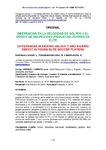Mostrar o rexistro simple do ítem
Diferencias de edad en el rendimiento de golpeo de balón en fútbol
| dc.contributor.author | Rodríguez Lorenzo, Lois | |
| dc.contributor.author | Fernández-del-Olmo, Miguel | |
| dc.contributor.author | Martín Acero, Rafael | |
| dc.date.accessioned | 2020-01-29T12:07:25Z | |
| dc.date.available | 2020-01-29T12:07:25Z | |
| dc.date.issued | 2019 | |
| dc.identifier.issn | 1577-0354 | |
| dc.identifier.uri | http://hdl.handle.net/2183/24788 | |
| dc.description.abstract | [Resumo]: El objetivo de este estudio fue examinar la evolución del rendimiento máximo de golpeo de balón a lo largo de la edad en futbolistas jóvenes de élite. Un total de 175 fueron divididos en 11 grupos edad (U-9 hasta U-19), además del equipo filial del club (U-23). Se registró la velocidad máxima de golpeo con la pierna dominante y no dominante mediante radar. El déficit de golpeo fue calculado para comparar el rendimiento entre ambas piernas. La velocidad máxima de golpeo aumenta progresivamente de forma significativa desde U-9 hasta U-16 con la pierna dominante y hasta U-18 con la no dominante, y sigue aumentando de forma no significativa hasta U-23. La etapa con mayor incremento de la velocidad de golpeo fue entre U-13 y U-16. Existe un déficit de golpeo con la pierna no dominante y sus valores permanecen estables (9.43%-18.18%) sin cambios significativos desde U-9 hasta U-23. | es_ES |
| dc.description.abstract | [Abstract]: The purpose of this current study was to examine the age-related differences in kicking performance with both legs in 175 youth soccer players. Players from the development programme of a professional club were grouped according to their respective under-age team (U-9 to U-18), in addition to the club’s second team (U-23). Maximal kicking velocity with the preferred and non-preferred leg was recorded using a Doppler radar gun. Kicking deficit was calculated to compare side-to-side performance. Maximal kicking velocity improved progressively from the U-9 to U-16 age groups for the preferred leg and from U16 to U-18 for the non-preferred leg, and continued to improve moderately but non-statistically significant until U-23. The stage of greatest kicking velocity development was between 13 and 16 years of age. There is a kicking deficit with the non-preferred leg and its values remain steady (9.43%-18.18%) without significant changes in players from U-9 to U-23 categories. | es_ES |
| dc.language.iso | spa | es_ES |
| dc.publisher | Vicente Martínez de Haro | es_ES |
| dc.relation.isreferencedby | Scopus | |
| dc.relation.uri | https://doi.org/10.15366/rimcafd2019.76.010 | es_ES |
| dc.rights | Atribución-NoComercial-SinDerivadas 3.0 España | es_ES |
| dc.rights.uri | http://creativecommons.org/licenses/by-nc-nd/3.0/es/ | * |
| dc.subject | Fútbol | es_ES |
| dc.subject | Velocidad | es_ES |
| dc.subject | Habilidad | es_ES |
| dc.subject | Rendimiento | es_ES |
| dc.subject | Golpeo | es_ES |
| dc.subject | Test | es_ES |
| dc.subject | Lateralidad | es_ES |
| dc.subject | Edad | es_ES |
| dc.subject | Football | es_ES |
| dc.subject | Kicking | es_ES |
| dc.subject | Performance | es_ES |
| dc.subject | Ability | es_ES |
| dc.subject | Testing | es_ES |
| dc.subject | Non-preferred leg | es_ES |
| dc.title | Diferencias de edad en el rendimiento de golpeo de balón en fútbol | es_ES |
| dc.title.alternative | Age-related differences in kicking performance in soccer | es_ES |
| dc.type | info:eu-repo/semantics/article | es_ES |
| dc.rights.access | info:eu-repo/semantics/openAccess | es_ES |
| UDC.journalTitle | Revista Internacional de Medicina y Ciencias de la Actividad Fisica y del Deporte | es_ES |
| UDC.volume | 19 | es_ES |
| UDC.issue | 76 | es_ES |
| UDC.startPage | 719 | es_ES |
| UDC.endPage | 728 | es_ES |
Ficheiros no ítem
Este ítem aparece na(s) seguinte(s) colección(s)
-
GI- ACOM - Artigos [29]






